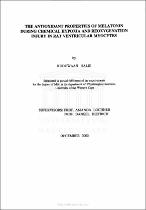| dc.description.abstract | It is well known that ischaemia chemical hypoxia followed by reperfusion is not always accompanied by recovery of myocardial function and often produces further cell damage (Hearse et al., 1973). This phenomenon commonly referred to as the oxygen paradox (Hearse et al., 1973), is usually characterised by extensive tissue damage and the formation of oxygen free radicals / reactive oxygen species (ROS). As the work on free radicals progressed it became apparent that there is a fine balance between cellular systems that produce free radicals and those that sustain their tolerable levels, to maintain normal cell function (Ferrari et al., 1990). The relative importance of free radicals in the production of irreversible cell damage, as well as the mechanisms involved are not fully understood. Using the rat mode of myocardial infarction followed by reperfusion, many investigators employed various antioxidants / free radical scavengers in various combinations at different stages of hypoxia / reoxygenation with the intention of reducing free radical mediated damage (Meerson et al., 1981; Shlafer et al., 1982; Stewart et al., 1983; Hess et a1., 1983; McCord and Fridovich, 1973). There is also an increasing interest in defining new antioxidants of high potency, low toxicity and good solubility properties in aqueous as well as organic phases. Recently it has been shown that melatonin (n-acetyl-5-methoxytryptamine) has the ability to directly scavenge free radicals (Reiter, 1993) It was therefore the aim of this study, to investigate oxidative stress during chemical hypoxia and reoxygenation in isolated rat ventricular myocytes and to study the antioxidant effects sf 6sl4fsnin, employed at different stages of chemical hypoxia and / or reoxygenation. To reveal the phenomenon of oxidative stress using laser scanning confocal microscopy, myocytes were preloaded with tetramethyl rhodamine (TMRM) together with one of the following fluorophores: (i) dihydric loro fluorescein diacetate (DCDHF) or dihydrorhodaminel23 (DHR) to illustrate the formation of HzOz and / or ROS; or (ii) fluo'3, AM (fluo) to show changes in intracellular free calcium. In superfused myocytes, chemical hypoxia was induced for 12.5 min by the addition of 1.5 mM KCN and 20 mM deoxy glucose to the superfusion buffer followed by 0, 1.5 or 15 min reoxygenation. Cells were also exposed to 27 .5 min chemical hypoxia without reoxygetration. Melatonin (50 pM) was added at different time intervals during the experimental protocol. All the myocytes (untreated and melatonin treated), indicated increased DCDHF but not DHR or fluo fluorescence under control oxygenated conditions (norrroxia). This probably implicate nonanal physiological levels of H2O2 and I or ROS and presumably an intact endogenous antioxidant system, since none of the cells suffered any damage. It was also indicated that melatonin had no effect on H2O2 and / or ROS formation and the viability of any of the cells during normoxia. Exposure of myocytes to chemical hypoxia for 12.5 min caused contracture and damage to 70 - 89 % of cells. This was associated with the generation of H2O2 and/ or ROS, an increase in intracellular calcium but maintenance of membrane potential. Early reoxygenation did not exacerbate or improve the changes observed during chemical hypoxia. Melatonin protected myocytes from hypoxic induced damage and increased cell viability from 20 to 80 % (p<0.05). Melatonin treated cells had reduced levels of ROS and intracellular calcium. The protection conferred by melatonin during exposure of cells to 12.5 min chemical hypoxia disappears if chemical hypoxia is prolonged to 27.5 min. After 27 -5 mn chemical hypoxia > 85 Vo of cells showed marked morphological changes and were considered to be irreversibly damaged. Myocytes indicated increased DCDHF; DHR and fluo fluorescence, implicating increased H2O2 and I or ROS formation and increased intracellular calcium respectively, after 12.5 min chemical hypoxia. However, the application of melatonin, effectively scavenged H2O2 and / or ROS and protected cells only for the first 14.5 min of chemical hypoxia, after which all of the cells indicated increased H2O2 and / or ROS formation, increased intracellular calcium and suffered irreversible damage. Presumably, as chemical hypoxia progressed, the accumulation of H2O2, the formation of ROS and degradation of endogenous antioxidant enzymes transpired, which resulted in damage to the majority of cells by the end of this period. | en_US |

